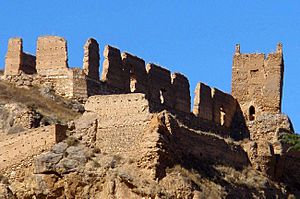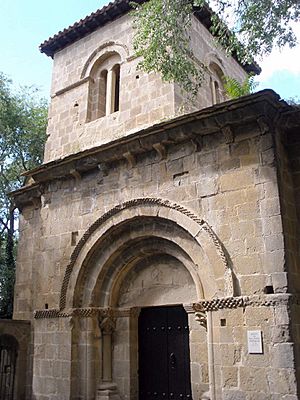Fortún Garcés Cajal facts for kids
Fortún Garcés Cajal (died 1146) was an important nobleman and leader from the Kingdom of Navarre and the Kingdom of Aragon. He was one of the most powerful figures during the time of King Alfonso the Battler. Fortún was very rich, owning a lot of land and money. He could even gather a large group of 200 to 300 knights to fight with him.
In 1113, Fortún took over the important areas of Nájera and Viguera. He managed these lands until 1135. After King Alfonso the Battler died in 1134, Fortún became a loyal supporter of King Alfonso VII of Castile.
Contents
Fortún's Land and Power
Fortún was likely born around 1075. We don't know much about his early life. He first appeared at King Alfonso the Battler's court in 1110. From then on, Fortún quickly became very important.
As a trusted helper of the king, Fortún was given control of several areas called tenencias (say: ten-EN-see-ahs). These were like territories where a nobleman would govern for the king. These were not passed down through families. Instead, the king decided who held them and for how long.
In 1113, Fortún took over the large and important areas of Nájera and Viguera. These lands were in the Kingdom of Castile, near the border with Aragon. Fortún could hold them because King Alfonso the Battler had married Queen Urraca of Castile. Even though their marriage ended in 1112, Alfonso still had influence in this border region. Fortún kept control of Nájera even after Alfonso's death in 1134. He then agreed to serve King Alfonso VII of Castile. Fortún was last recorded as controlling Nájera in 1135. By 1139, another nobleman, Count Lope Díaz de Haro, had taken his place.
Fortún also fought many battles with the king during the Reconquista (say: Reh-kon-KEES-tah). This was a long period when Christian kingdoms in Spain fought to take back lands from Muslim rulers. In 1121, King Alfonso rewarded Fortún by giving him control of Tudela (conquered in 1119) and Daroca (conquered in 1120). In 1127, Tudela was given to a French count named Rotrou III of Perche, who had come to help with the Reconquista.
Around 1130–31, Fortún's household also took in two criatores (say: cree-ah-TOR-es). These were children who were raised and educated in the home of a powerful nobleman.
Fortún was also made lord of Ullé, a place near Jaca in the heart of old Aragon. By 1133, he had given some of his responsibilities to two relatives, García Cajal and Lope Cajal. The king formally approved this in 1133.
Helping King Ramiro II
After King Alfonso the Battler died in September 1134, the kingdoms of Aragon and Navarre split apart. The people of Navarre chose García Ramírez as their king. The Aragonese chose Alfonso's younger brother, Ramiro II. Part of old Navarre, including Nájera, was taken by King Alfonso VII of Castile.
During Ramiro's short time as king (1134–37), Fortún was his closest and most important advisor. In January 1135, Fortún helped create the Pact of Vadoluengo. This agreement gave Aragon power over Navarre and set their shared border.
Because of these events, Fortún's lands were spread across three different kingdoms. He managed to keep control of Nájera. In 1136, while traveling through Navarre, he was captured by King García's men. To pay for his release, he had to sell many of his properties in Aragon and Navarre. He sold them to the rich monastery of San Salvador de Leire. Fortún was set free in 1137, but he had lost much of his wealth and power.
Building a Church
In 1133, Fortún and his wife, Toda, gave some land and a church to the Cluniac monastery of Santa María de Nájera. The church was dedicated to San Adrián. They also gave land and a church at Sangüesa, and other properties at Aibar and Alcatén. Fortún and Toda kept the right to use these properties during their lifetimes. They probably wanted these gifts to become a new Cluniac monastery after they died.
After he was freed in 1137, Fortún tried to get some of his properties back from the Leire monastery. In the same year, he and Toda gave a manor house and land in Sangüesa to their chaplain, a French monk named Peter. This was meant to be the start of a new monastery. This new monastery would pray for Fortún, his wife, their late son, and for past kings Peter I and Alfonso. In this document, Fortún called these kings his relatives.
In 1141, Fortún and Toda changed their plans. With the help of Sancho de Larrosa, the bishop of Pamplona, they gave the church and land at Vadoluengo directly to the main Cluny Abbey in France. This made it a priory (a smaller monastery) directly under Cluny. They also gave the manor and land at Sangüesa to Cluny. These gifts formed the new Cluniac monastery of San Adrián de Sangüesa. Cluniac monks moved into their new priory on the day it was officially started.
By 1145, Fortún's wife, Toda, had died. Bishop Sancho de Larrosa had also been replaced by Lope de Artajona. In that year, Fortún repeated his gift of 1141 to make sure there were no doubts about it. He did this with the approval of Bishop Lope and in front of several important abbots.
Fortún's Properties
Fortún and Toda owned land all over the Ebro valley and in Navarre. Records show they owned at least 25 different properties. Most of these were houses with surrounding land. The center of their many properties seemed to be Sangüesa. Many of their lands in the Ebro valley were in the area between Tarazona, Tudela, and Zaragoza. These properties were not all connected but were managed separately. Fortún and Toda owned all their property together, even lands Fortún received from the king. They mostly acted as landlords, collecting rents and goods.
Fortún gained many of his lands in the Ebro valley after fighting alongside King Alfonso in the Reconquista. Lands taken from Muslim owners would become the king's property. The king would then give these lands as gifts to important noblemen like Fortún. These newly conquered lands were often well-developed and could be used right away.
In 1127, Fortún received seven properties from the king. These were in places like Almorata, Borja, Pedrola, and Tarazona in Aragon, and Fontellas in Navarre, and in Zaragoza. These properties were allodial, meaning they were fully owned and not held from a lord. The king spread out these gifts to prevent any one nobleman from gaining too much power in one area. Noblemen sometimes tried to gather their lands together, but they also liked having lands spread out to increase their influence.
Fortún and his wife sometimes invested in their properties. They built a mill, likely for grinding grain, at Murillo de Limas, near Tudela. This mill became known as the molino de Cajar. They also built a mill and a tienda (store) at Tarazona. Around 1120, Fortún also built a bridge with a hospital and a church dedicated to Saint John at Gronium, a crossing point on the Ebro river. This helped pilgrims traveling along the Way of Saint James.
A "tower of Cajal" in Zaragoza, near the Gállego river, was mentioned in old documents. It probably belonged to Fortún.
His Will and Death
Fortún and Toda first wrote their will in October 1133. In this will, they left gifts to the military orders of the Templars and Hospitallers. They also gave money to the cathedral of Saint Mary of Bethlehem in the Holy Land. The Hospitallers received land in Tarazona, Tudela, and Zaragoza. The Templars received land in Tudela, Fontellas, and other places, as well as a mill and a grove at Alcaten.
Late in 1133, Fortún's son, García Cajal, was killed in battle while fighting with King Alfonso the Battler. Fortún's nephew, Lope Cajal, died at the Battle of Fraga in 1134. He left his lands to the Templars.
In 1141, Fortún and Toda wrote their second and final will. In it, Fortún divided his wealth among his nephews, Fortún Íñiguez and Sancho Íñiguez.
Fortún died in 1146, as shown by two documents from the Templars.
See also
 In Spanish: Fortún Garcés Cajal para niños
In Spanish: Fortún Garcés Cajal para niños



